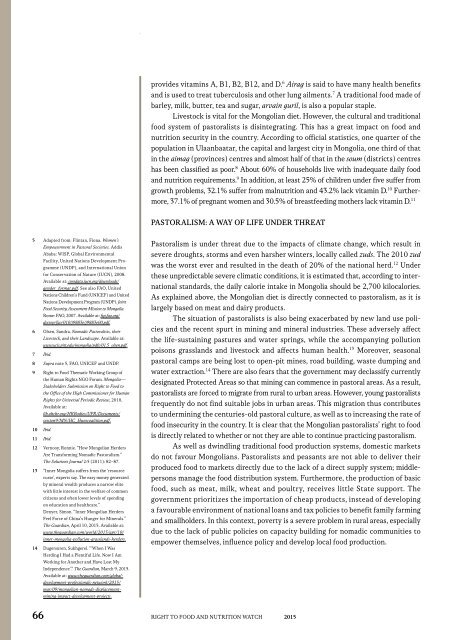RIGHT TO FOOD AND NUTRITION WATCH
1iNBHTY
1iNBHTY
You also want an ePaper? Increase the reach of your titles
YUMPU automatically turns print PDFs into web optimized ePapers that Google loves.
provides vitamins A, B1, B2, B12, and D. 6 Airag is said to have many health benefits<br />
and is used to treat tuberculosis and other lung ailments. 7 A traditional food made of<br />
barley, milk, butter, tea and sugar, arvain guril, is also a popular staple.<br />
Livestock is vital for the Mongolian diet. However, the cultural and traditional<br />
food system of pastoralists is disintegrating. This has a great impact on food and<br />
nutrition security in the country. According to official statistics, one quarter of the<br />
population in Ulaanbaatar, the capital and largest city in Mongolia, one third of that<br />
in the aimag (provinces) centres and almost half of that in the soum (districts) centres<br />
has been classified as poor. 8 About 60% of households live with inadequate daily food<br />
and nutrition requirements. 9 In addition, at least 25% of children under five suffer from<br />
growth problems, 32.1% suffer from malnutrition and 43.2% lack vitamin D. 10 Furthermore,<br />
37.1% of pregnant women and 30.5% of breastfeeding mothers lack vitamin D. 11<br />
PAS<strong>TO</strong>RALISM: A WAY OF LIFE UNDER THREAT<br />
5 Adapted from: Flintan, Fiona. Women’s<br />
Empowerment in Pastoral Societies. Addis<br />
Ababa: WISP, Global Environmental<br />
Facility, United Nations Development Programme<br />
(UNDP), and International Union<br />
for Conservation of Nature (IUCN), 2008.<br />
Available at: cmsdata.iucn.org/downloads/<br />
gender_format.pdf. See also FAO, United<br />
Nations Children’s Fund (UNICEF) and United<br />
Nations Development Program (UNDP). Joint<br />
Food Security Assessment Mission to Mongolia.<br />
Rome: FAO, 2007. Available at: ftp.fao.org/<br />
docrep/fao/010/j9883e/j9883e00.pdf.<br />
6 Olsen, Sandra. Nomadic Pastoralists, their<br />
Livestock, and their Landscape. Available at:<br />
www.ucis.pitt.edu/mongolia/pdfs/01.5_olsen.pdf.<br />
7 Ibid.<br />
8 Supra note 5, FAO, UNICEF and UNDP.<br />
9 Right to Food Thematic Working Group of<br />
the Human Rights NGO Forum. Mongolia—<br />
Stakeholders Submission on Right to Food to<br />
the Office of the High Commissioner for Human<br />
Rights for Universal Periodic Review, 2010.<br />
Available at:<br />
lib.ohchr.org/HRBodies/UPR/Documents/<br />
session9/MN/HC_Hunscoalition.pdf.<br />
10 Ibid.<br />
11 Ibid.<br />
12 Vernooy, Ronnie. “How Mongolian Herders<br />
Are Transforming Nomadic Pastoralism.”<br />
The Solutions Journal 2:5 (2011): 82–87.<br />
13 “Inner Mongolia suffers from the ‘resource<br />
curse’, experts say. The easy money generated<br />
by mineral wealth produces a narrow elite<br />
with little interest in the welfare of common<br />
citizens and often lower levels of spending<br />
on education and healthcare.”<br />
Denyer, Simon. “Inner Mongolian Herders<br />
Feel Force of China’s Hunger for Minerals.”<br />
The Guardian, April 10, 2015. Available at:<br />
www.theguardian.com/world/2015/apr/10/<br />
inner-mongolia-pollution-grasslands-herders.<br />
14 Dugersuren, Sukhgerel. “‘When I Was<br />
Herding I Had a Plentiful Life. Now I Am<br />
Working for Another and Have Lost My<br />
Independence’.” The Guardian, March 9, 2015.<br />
Available at: www.theguardian.com/globaldevelopment-professionals-network/2015/<br />
mar/09/mongolian-nomads-displacementmining-impact-development-projects.<br />
66<br />
Pastoralism is under threat due to the impacts of climate change, which result in<br />
severe droughts, storms and even harsher winters, locally called zuds. The 2010 zud<br />
was the worst ever and resulted in the death of 20% of the national herd. 12 Under<br />
these unpredictable severe climatic conditions, it is estimated that, according to international<br />
standards, the daily calorie intake in Mongolia should be 2,700 kilocalories.<br />
As explained above, the Mongolian diet is directly connected to pastoralism, as it is<br />
largely based on meat and dairy products.<br />
The situation of pastoralists is also being exacerbated by new land use policies<br />
and the recent spurt in mining and mineral industries. These adversely affect<br />
the life-sustaining pastures and water springs, while the accompanying pollution<br />
poisons grasslands and livestock and affects human health. 13 Moreover, seasonal<br />
pastoral camps are being lost to open-pit mines, road building, waste dumping and<br />
water extraction. 14 There are also fears that the government may declassify currently<br />
designated Protected Areas so that mining can commence in pastoral areas. As a result,<br />
pastoralists are forced to migrate from rural to urban areas. However, young pastoralists<br />
frequently do not find suitable jobs in urban areas. This migration thus contributes<br />
to undermining the centuries-old pastoral culture, as well as to increasing the rate of<br />
food insecurity in the country. It is clear that the Mongolian pastoralists’ right to food<br />
is directly related to whether or not they are able to continue practicing pastoralism.<br />
As well as dwindling traditional food production systems, domestic markets<br />
do not favour Mongolians. Pastoralists and peasants are not able to deliver their<br />
produced food to markets directly due to the lack of a direct supply system; middlepersons<br />
manage the food distribution system. Furthermore, the production of basic<br />
food, such as meat, milk, wheat and poultry, receives little State support. The<br />
government prioritizes the importation of cheap products, instead of developing<br />
a favourable environment of national loans and tax policies to benefit family farming<br />
and smallholders. In this context, poverty is a severe problem in rural areas, especially<br />
due to the lack of public policies on capacity building for nomadic communities to<br />
empower themselves, influence policy and develop local food production.<br />
<strong>RIGHT</strong> <strong>TO</strong> <strong>FOOD</strong> <strong>AND</strong> <strong>NUTRITION</strong> <strong>WATCH</strong> 2015


